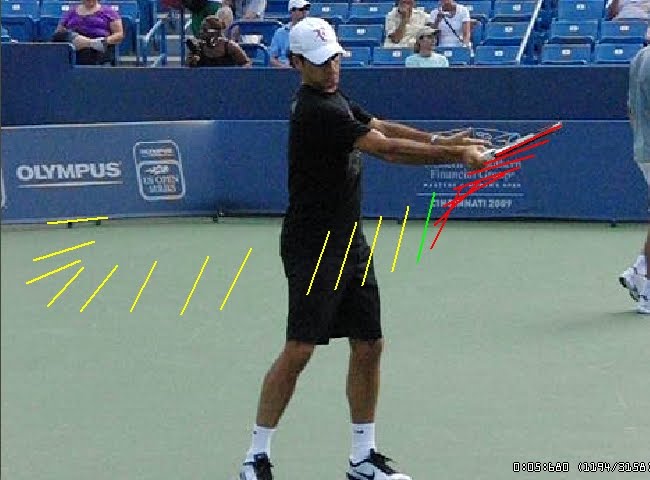Some camera viewing angles for the serve.
All positions may show better some interesting feature of the tennis strokes because they are so 3D. Tennis is more 3D than golf.
I believe that Rozroz just placed a smartphone with its wide angle lens on the ground. Very useful video. The first picture was typical of the HD video image sharpness. The bright sunlight resulted in very small motion blur. Very informative but to compare it to other high speed videos is difficult.
Hand held, arms high with camera, standing behind server, viewing along the trajectory but a little low. Because of a fast shutter speed and 240 fps frame rate the rotations of the ball could be seen. Rotation was 3600 RPM.
https://vimeo.com/92106325
Overhead View. The camera directly above is best because overhead videos are so very rare. FYB created the best videos from above. Toly has made some very informative composite pictures and videos from them.
Camera Views Along & Perpendicular to the Ball's Trajectory. To get some experience in how strokes look in high speed videos, I believe that it is best to limit the camera viewing angles. I like camera viewing along the ball's trajectory and also viewing perpendicular to the ball's trajectory. That is different than from 'the side', usually parallel to the baseline, and 'behind' which is not defined but could mean looking along the court centerline. That's often done so that the camera does not have to be moved.
For the serve, being behind the server and looking along the court's centerline is not the same as viewing along the ball's trajectory.
Trajectory Differences Ad & Deuce Sides. The ad and deuce serves have too much difference in direction to not re-point the camera. Using a protractor and copy of the court - balls to the centers of the ad and deuce service boxes have trajectories that are roughly 24° apart. For wide serves the angles could be as much as twice that, maybe 40-50° different. That is too large an angle for comparing serves from the deuce and ad courts without re-locating the camera. Of course, you can't eliminate the variation in the ball's trajectories from serve to serve.
Camera Height for Serve to View Along Ball's Trajectory. For height and looking along the trajectory, the fence is about 10' high and is pretty good but the fence is not high enough to look directly along the trajectory of a 6' tall server. To get a better angle you can use a ladder and move closer to the server. Clamping a tripod, with a geared elevator and adjustable head, to anything is an advantage because the camera's head is designed to adjust the camera's pointing angle.








